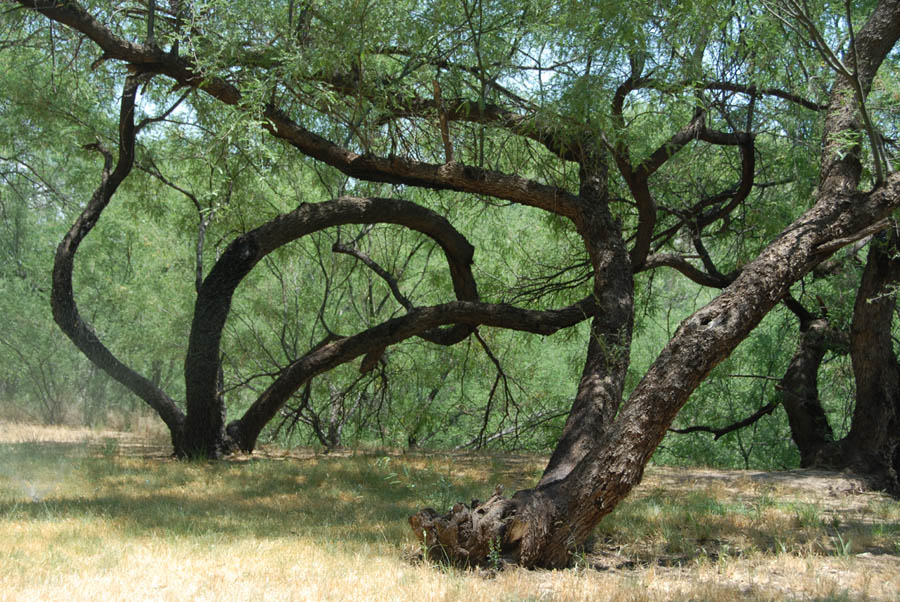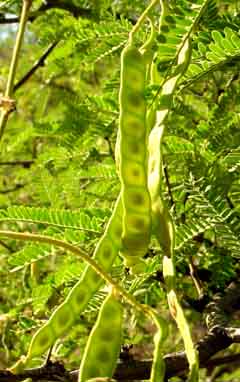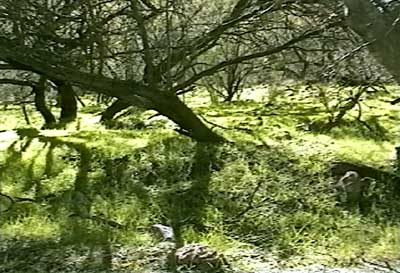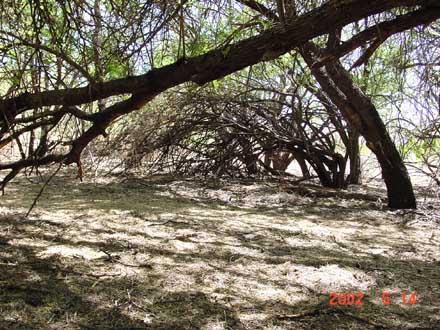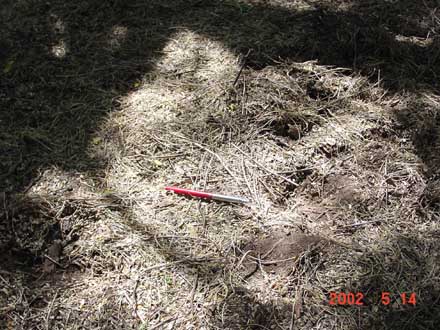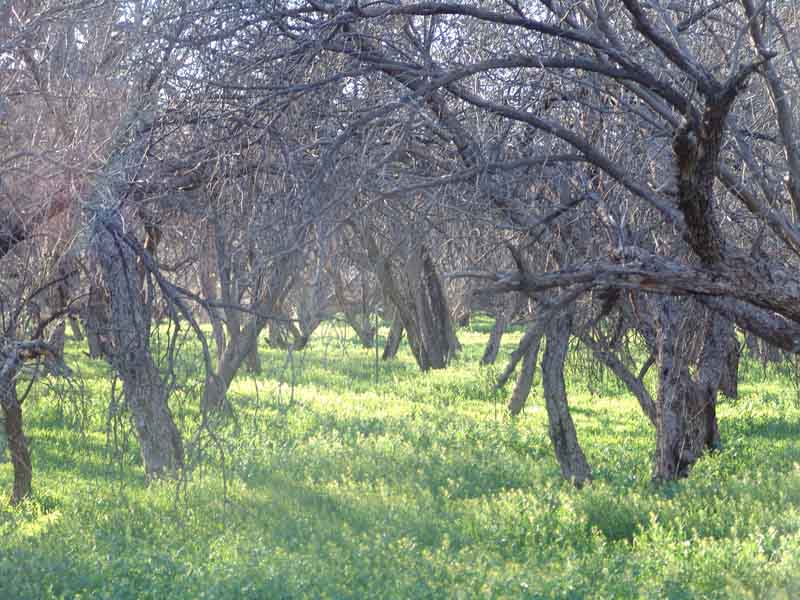
Mesquites (Prosopis spp.)
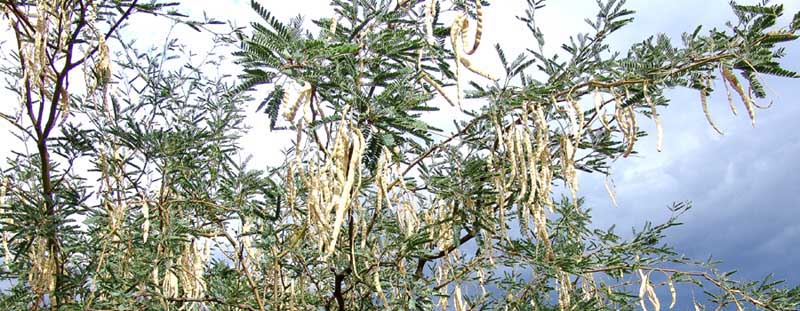
Main Sources: Hastings, James & Raymond Turner, 1965, The Changing Mile, University of Arizona Press; Petrides, George & Olivia Petrides, 1992, A Field Guide to Western Trees, pp. 114-15; Dimmit, Mark, "Fabaceae (legume family)", in Steven Phillips and Patricia Comus, eds., 2000, A Natural History of the Sonoran Desert, pp. 236-38, Arizona-Sonora Desert Museum Press, Tucson; Hultine, Kevin, "The Taxonomy of North and South American Mesquites", Aridus 13:2:May 2001;. Hodgson, Wendy, Food Plants of the Sonoran Desert, Tucson: University of Arizona press.
The banner photograph above at the top shows a mesquite bosque ("dense forest") near the Teran Wash confluence with the San Pedro River in March 2005, when the leaves are off the trees. (The green vegetation on the floor of the old floodplain is mostly London Rocket, an invasive species in our area.) The photo below it shows mesquite pods ripening in Lower Hot Springs Canyon in July 2006
Below we view mesquite bosque located at the triple confluence of the San Pedro River with Paige Wash and Hot Springs Canyon Wash (taken on May 9, 2002). The ridge dividing the Paige Wash drainage (coming down from the Rincon Mountains complex in the background) from the San Pedro River runs across the middle-left part of the photo, petering out at the confluence roughly at the center. The canopy-breaking taller trees visible both along the San Pedro (its channel visible at lower right) and along lower Paige Wash are portions of Cottonwood-Willow Gallery Forest, while most of the remaining green foliage is mesquite.
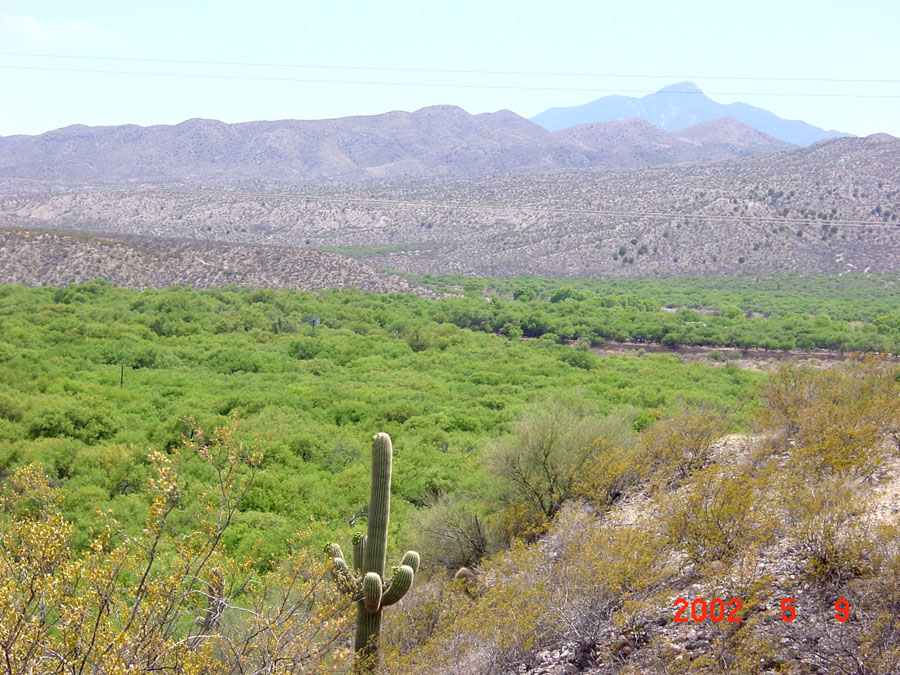
Based on the density and spread of this bosque, you might think mesquites had been the dominant vegetation along the San Pedro Drainage for a very long time, but this kind of prominence is historically quite recent in our area.
Mesquites, a leguminous (bean-pod-bearing) tree, are relatives of the Acacias, but unlike the latter (whose wider distribution throughout the now-scattered southern continents links them to the Late Jurassic Era and the ancient supercontinent Gondwanaland), the native home of mesquites is Argentina in South America, indicating that their ancestors evolved after South America separated from Africa in the breakup of Gondwanaland (between 144 and 100 MYA, during the Early Cretaceous Era). By the late Eocene epoch (less than 50 MYA), mesquites reached North America, perhaps over the emergent Panamanian land bridge, from their South American homelands.
Mesquites were apparently present in some parts of Southeastern Arizona during the Pleistocene epoch (from 1.8 million to around 11,000 years ago), where they coevolved with mega-herbivores, who ate the pods and then fertilized and dispersed them with their feces. After the extinction of these herbivores at the end of the last Ice Age (see Late-Pleistocene Megafauna), the range of mesquites apparently became much more constricted -- until the introduction of European cattle, who re-filled the role of the ancient herbivores and caused mesquite to spread rapidly and much more widely than before. In the bottomlands where cattle tend to graze most intensively, mesquite out-competes grasses for water and light, and so after generations of heavy grazing, very dense stands of these trees become permanent. Before 1880, the San Pedro Valley contained open grasslands as well as cienegas along with occasional stands of mesquite (which was not nearly so pervasive here as it has since become), but as water tables fell mesquites gained advantage.
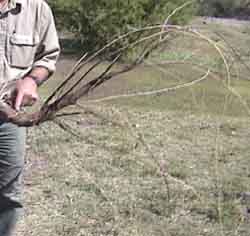 Today, mesquites are found mainly below 5,000' elevation. The mesquite root system is the deepest known, reaching in some rare cases more than 100 feet down, though 90% of the tree's roots are located in the upper 3 feet of soil and in some places in our desert where water pumping has dropped the groundwater below 50 feet, whole bosques have died out.
Today, mesquites are found mainly below 5,000' elevation. The mesquite root system is the deepest known, reaching in some rare cases more than 100 feet down, though 90% of the tree's roots are located in the upper 3 feet of soil and in some places in our desert where water pumping has dropped the groundwater below 50 feet, whole bosques have died out.
At left, you can get a sense of mesquite root density from a very young uprooted tree. They quickly become nearly impossible to uproot. (Click on this image to enlarge it.)
This root system gives them a strong competitive advantage in floodplains, where they are by far most commonly found. Where they occur on dry uplands, they are reduced to small shrubs in size.
Speaking aesthetically, walking in a mesquite bosque can be an illuminating experience. These trees seem to follow their own imagination in constructing their architectures: (Click on this image to enlarge it.)
Below, mesquite leaves yellowing in December 2002, after meager but much-needed fall rains:
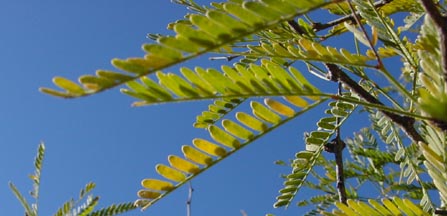
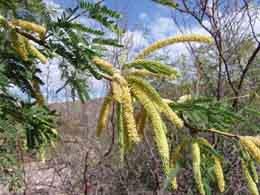 The most common mesquite in our area is the "Velvet Mesquite" (Prosopis velutina), which is distinguished by having typically 4 major leaflets, and 10 to 20 pairs of minor leaflets, on each twice-compounded leaf (see leafs and
major-&-minor leaflets to the left (click on image to enlarge). The leaflets are fuzzy and dull-green in color. Click here for a closer view of leaf and leaflet structure.
The most common mesquite in our area is the "Velvet Mesquite" (Prosopis velutina), which is distinguished by having typically 4 major leaflets, and 10 to 20 pairs of minor leaflets, on each twice-compounded leaf (see leafs and
major-&-minor leaflets to the left (click on image to enlarge). The leaflets are fuzzy and dull-green in color. Click here for a closer view of leaf and leaflet structure.
The flowers (also shown to the left) bloom from April into May. Note the varying degrees of ripeness in the different catkins (cylindrical, petalless, unisexual flowers), which become pale yellow spikes about 3" long, and slightly fragrant when ripe.
The fruits are long, narrow, flattened, non-splitting seed pods. At left, the young pods of velvet mesquite in June. Note the translucence of developing pods as the afternoon light shines through them. (Click on this image to enlarge it.)
Below right, mature beans, ready for milling.

Mesquite pods have served as critical food for indigenous people. The pod has a thin skin, within which lies a mealy pulp (containing the seeds), which is quite sweet (about 20% sugars). The seeds, which are enclosed in a hard woody covering, are about 35% protein -- a very high proportion, making it a high-quality food indeed.
Not only is mesquite flour highly nutritious, it is also potentially valuable for conserving ecosystems in that it can be made into a kind of "bread" without baking (so that less wood need be wasted as fuel -- see Dimmit, reference listed above, on this point).
Historically, the problem with processing mesquite as a food is the difficulty in separating the seeds and pulp from their inedible woody covering. In Saguaro-Juniper we use a hammer-mill (see), which does the job nicely (but is not easy to come by -- in 2000 we bought one from a local rancher for $250 and reconditioned it). See Mesquite Bean Milling 2001 for an account of our initial efforts. Since that time we have conducted cooperative milling operations nearly every year, with each event drawing more people, processing more beans, and employing more sophisticated technologies. Click on this link to see a brief image report on our most recent milling, which will give a sense of the technological evolution of our work: Mesquite Processing 2006. [For more details on food uses, see this link: Daniel Baker's Wildfoods Logbook.]
Mesquite wood is very hard and durable. O'odham used it for all kinds of construction where posts were needed, and contemporary builders and furniture makers regard it as a material of exceptional quality.
Mesquite Bosque
Where mesquite forests become dense, they tend to crowd out most other forms of vegetation, sometimes forming a floor which is soft to the foot, comprising a fine vegetative "duff" -- detritus from the tree, which makes an excellent fertilizing compost or mulch. In rainy seasons the floor may become a green carpet of native annual plants, as at left, a terrace in Upper Hot Springs Canyon during February of 1995 (click on the image to enlarge it).
The banner photo at the top of the page shows a similar condition, though the green growth there is mainly the invasive London Rocket.
During times of drought, as below (May 2002), the floor may become entirely barren, and the duff may become so dry that it will support the spread of fire: (Click on each image below to enlarge it.)
The duff itself, however, is nitrogen-rich and hence has considerable value as a mulch for gardens.
Below, a mesquite tree photographed in November of 2007 has been yellowing its leaves (in a time of warm-weather drought), and dropping them to form a ring of new duff:
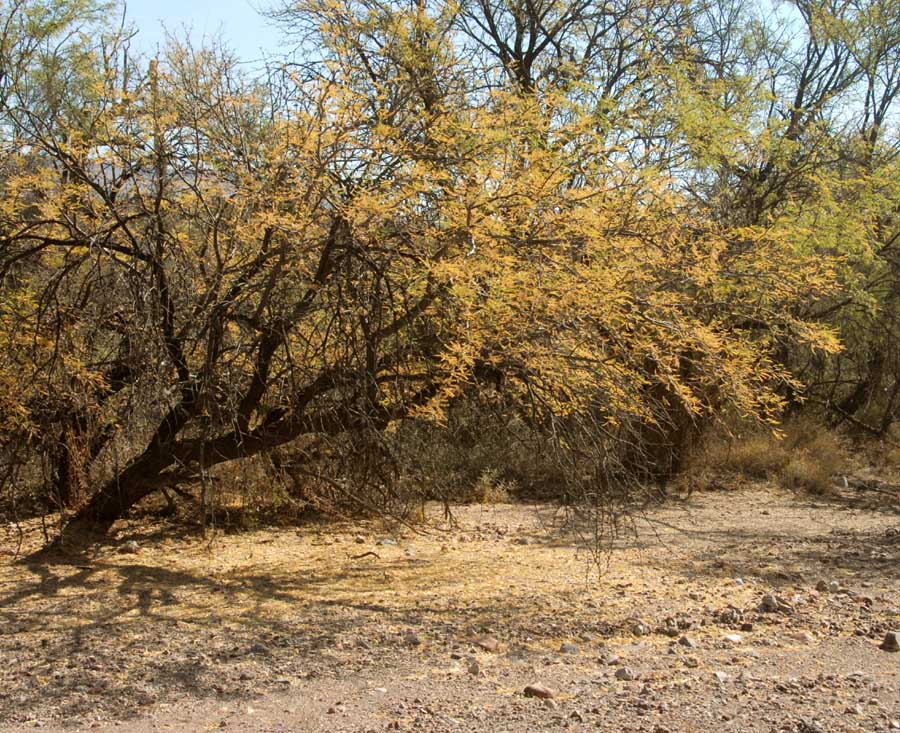
Note the distinct "pool" of yellow duff forming directly below the tree -- contrasting with the grayish soil around it.
